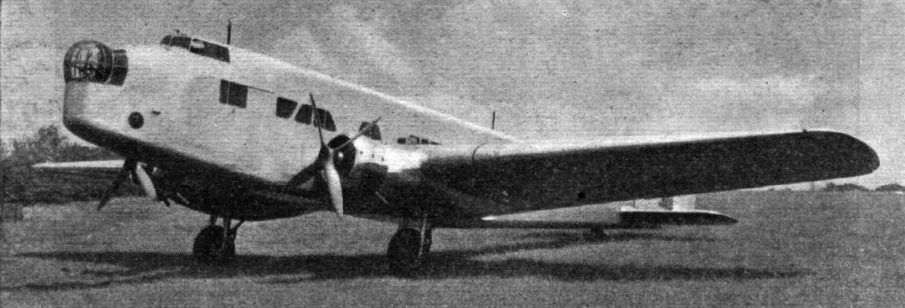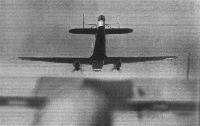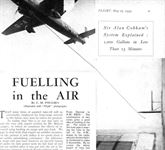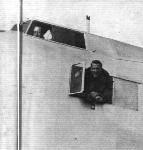
Flight, June 1935
NEW and EXPERIMENTAL TYPES at HENDON
Armstrong Whitworth A.W. 23: Designed and built by Sir W. G. Armstrong-Whitworth Aircraft, Ltd., the A.W.23 is a low-wing cantilever monoplane in which aerodynamic efficiency has been raised to a high degree of perfection. This has been achieved by suppressing all drag-producing excrescences, notably the undercarriage (which is retractable) and bombs (which are stowed inside the machine and not carried under the wings) There are enclosed turrets for front and rear gunners, and the pilot's cockpit is totally enclosed. The machine can be used alternatively for the transport of troops and stores, as a heavy bomber, or as an ambulance. The engines fitted are two Siddeley “Tiger VI” fourteen-cylinder radials of 760-810 b.h.p. each, faired into the leading edge of the wing. The span is 88ft. and the length 80ft. 9in.
- Flight, June 1935
NEW and EXPERIMENTAL TYPES at HENDON
Фотографии
-
Flight 1935-06 / Flight
Регистрационный номер: K3585 [27] A new Bomber Transport: The Armstrong Whitworth A.W.23, which has two 800 h.p. Siddeley "Tiger VI" engines.
-
Flight 1936-06 / Flight Advertisements
Регистрационный номер: K3585 [27] -
Flight 1935-06 / Flight
Регистрационный номер: K3585 [27] THE LATEST: It is now permissible to publish a photograph of the new Armstrong-Whitworth Bomber Transport - a low-wing cantilever monoplane with retractable undercarriages. The engines are Siddeley "Tigers."
-
Aeroplane Monthly 1985-06 / ??? - RAF Pageantry
Регистрационный номер: K3585 [27] The A.W.23 bomber transport, powered by two 810 h.p. Armstrong Siddeley Tigers, being demonstrated by Flt Lt C. E. Horrex.
-
Flight 1935-10 / Flight
Регистрационный номер: K3585 [27] -
Flight 1936-01 / Flight Advertisements
Регистрационный номер: K3585 [27] -
Flight 1935-10 / Flight
Регистрационный номер: K3585 [27] -
Flight 1936-01 / Flight
Регистрационный номер: K3585 [27] OUTSTANDING 1935 MILITARY TYPE. The A.W. XXIII is a new bomber transport with two 760 h.p. Tiger VI engines.
-
Flight 1935-10 / Flight
Регистрационный номер: K3585 [27] In the nose and tail of the A.W. XXIII there is an Armstrong-Whitworth revolving gun turret. The position from which this photograph was taken - the gunner's cockpit in a following machine - would be by no means an enviable one in time of war.
-
Flight 1936-01 / Flight Advertisements
Регистрационный номер: K3585 [27] With two 760 h.p. Siddeley Tiger VI engines the A.W.XXIII bomber transport has a high performance.
-
Flight 1936-10 / Flight
Регистрационный номер: K3585 [27] CIVILISING INFLUENCE: The Armstrong Whitworth XIII Bomber Transport which is being handed over to Imperial Airways after suitable modifications have been made for its use as a transport rather than as a bomber. This machine has been fitted with Tiger IX's (790/880 h.p.) and D.H. v.p. airscrews and was designed to carry twenty-four soldiers with full equipment. It might be suggested that the nose and tail cupolas should be retained for use by any passengers who are prepared to pay for the excellent view obtained.
-
Flight 1935-10 / Flight
Регистрационный номер: K3585 [27] A SERVICE HEAVYWEIGHT. The Armstrong Whitworth bomber transport monoplane flies high and fast, presenting a magnificent "shot" for Flight's photographer. With two Siddeley Tiger VI engines not only does the machine possess remarkable weight-carrying properties, but it is extremely fast for an aircraft in its class and has, in addition, a long range.
-
Flight 1936-01 / Flight Advertisements
Регистрационный номер: K3585 [27] -
Авиация и Космонавтика 2020-07 / Ю.Кузьмин - Дозаправка в воздухе: от первых опытов к первому в мире беспилотному заправщику
Регистрационный номер: K3585 [27] Заправщик A.W.23 и летающая лодка S.23 Empire над Атлантикой перед дозаправкой
Другие самолёты на фотографии: Short Empire / S.23 - Великобритания - 1936
-
Flight 1939-01 / Flight
Регистрационный номер: K3585 [27] REFUELLING EXPERIMENT: For some time experiments have been going on at Ford aerodrome under Sir Alan Cobham's direction. In this photograph the Short Cambria is being refuelled by the A.W.23 used for the work.
Refuelling will be the important feature of this year's Atlantic experiments as far as this country is concerned. Cambria is shown above taking on fuel (or pretending to, for the benefit of the photographer) from the A.W.XXIII, which has been used for experiments at Ford aerodrome.
The sole AW23, K3585, makes a refuelling contact with Short S.23 G-ADUV Cambria.Другие самолёты на фотографии: Short Empire / S.23 - Великобритания - 1936
-
Flight 1939-05 / Flight
Регистрационный номер: K3585 [27] REFUELLING TESTS: An Armstrong Whitworth A.W.23, acting as the “receiver,” taking on fuel from a Handley Page Harrow, used as the “tanker.” The hose pipe passes from the forward part of the tanker to the stern of the aircraft to be fuelled. Our photograph was taken from the latter machine.
Другие самолёты на фотографии: Handley Page Harrow / H.P.54 - Великобритания - 1936
-
Flight 1939-05 / Flight
Регистрационный номер: K3585 [27] From Harrow A.W. XXIII: combination of views gives a good idea of fuelling in the air. The nozzle of the hose pipe is nearing the cone in the tail of the A.W., drawn by the cable, which is shown slightly thickened to make it discernible. By no means the whole length of hose had been reeled off when the picture was taken.
Другие самолёты на фотографии: Handley Page Harrow / H.P.54 - Великобритания - 1936
-
Flight 1939-05 / Flight
Регистрационный номер: K3585 [27] Inside the receiving aircraft: On the back of the cone are the toggles and their piping. The hauling line passes through the central tube to the winch. The petrol pipes run from the two flanges to the tanks, but were not in place when this picture was taken.
-
Flight 1939-05 / Flight
Регистрационный номер: K3585 [27] The cone in the stern of the receiving aircraft: The ends of the toggles can just be seen projecting through their slits. The weighted grapnel on the end of the hauling line is seen on top of the cockpit coaming. Note that the cable passes through the centre of the cone, into the pipe shown in the internal view on the left.
-
Air Pictorial 1956-12 / Lintonian - The Whitley story (1)
Регистрационный номер: K3585 [27] K3585, the sole example of the AW.23 bomber-transport built
-
Flight 1935-07 / Flight
Регистрационный номер: K3585 [27] A low-altitude aerial view of the "New and Experimental" park. The big machine in the centre, dwarfing the D.H. "Comet" in front of it, is the A.-W. bomber transport.
Другие самолёты на фотографии: De Havilland Comet / D.H.88 - Великобритания - 1934
-
Aeroplane Monthly 1985-06 / ??? - RAF Pageantry
Регистрационный номер: K3585 [27] Aerial view of the New Types park with the A.W.23 in the centre.
Другие самолёты на фотографии: De Havilland Comet / D.H.88 - Великобритания - 1934
-
Aeroplane Monthly 1985-05 / A.Lumsden, T.Heffernan - Probe Probare (12)
Регистрационный номер: K3585 [27] G-ADSR at Hamble before its first flight. In the background on the left is the A.W.23 bomber-transport prototype, K3585.
Другие самолёты на фотографии: Armstrong Whitworth Ensign / A.W.27 - Великобритания - 1938
-
Flight 1938-01 / Flight
Регистрационный номер: K3585 [27] TROOPER-TANKER: The hose reel on the A.W.23 troop carrier now being used by Sir Alan Cobham for refuelling experiments on the South Coast. An Empire boat has already acted as refuellee.
-
Flight 1935-10 / Flight
Регистрационный номер: K3585 [27] -
Flight 1936-01 / Flight Advertisements
Регистрационный номер: K3585 [27] THE AW GUN TURRET: A MOUNTING for a free gun approved by the British Air Ministry for any station on modern high performance aircraft. A patented system of linkage relieves the gunner of the influence of accelerations. The operation is entirely manual.
-
Flight 1936-01 / Flight
Регистрационный номер: K3585 [27] Installation of the turret in the tail of the A.W. XXIII.
-
Flight 1936-01 / Flight
These diagrams show the method of operation of the A.W. turret. The gunner stands to fire downwards.
-
Aviation Historian 25 / B.Gardner - Fill 'er up!
Hauling-line from AW.23 snags wingtip-hook of Harrow; hook (attached to contact-line running beneath wing to Harrow cabin), sinker-weight and hauling-line drop free, to be hauled aboard Harrow; refuelling line attached to hauling-line and winched back to AW.23, which refuels and disconnects refuelling line when full; refuelling line hauled back aboard Harrow
Другие самолёты на фотографии: Handley Page Harrow / H.P.54 - Великобритания - 1936
- Фотографии




























